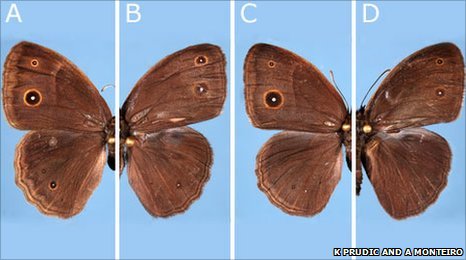|
By Ella Davies
Earth News reporter
|

Male and female butterflies switch courting roles depending on the season they were born in, say scientists. Squinting bush brown butterflies use reflective "eye spots" on their wings to attract potential mates. Males
born in the wet season beat their wings to flash their spots but in the
dry season females grow brighter spots instead and take the lead. This behaviour could benefit females, allowing them to control mating when fewer food resources are available.
 |
BUTTERFLY EYE SPOTS
Eye spots on the underside of butterfly wings are used to deter predators
Eye spots on the surface of the wing are used to attract mates and warn off rivals
|
Published in the journal Science, the study is the first to show
that butterflies develop sexual ornamentation in response to their
environment. Like many butterfly species, squinting bush brown butterflies (Bicyclus anynana) perform wing-beating courtship displays to attract potential mates. Unusually, the male and female butterflies take it in turns to lead this courting behaviour depending on the season. Males beat their wings to attract mates in the warmer wet season and in the cooler dry season, the roles are reversed. In
many butterfly species, members of the courting sex have more
ornamented wing surfaces with distinctive eye spots that they flash at
potential mates in wing-beating displays. However, to the human eye both sexes of B. anynana sport very similar surface wing patterns. So
in order to understand the role-switching, researchers at Yale
University, Connecticut, US analysed courtship displays from a
butterfly's perspective. Led by Dr Antonia Monteiro, the team
found that the white "pupil" at the centre of each butterfly's eye spot
reflects different amounts of ultraviolet (UV) light, depending on what
temperature the butterfly was reared at when a larvae.

Wet
and dry season surface wing patterns look similar to the human eye. A:
Wet season female B: Wet season male C: Dry season female D: Dry season
male
"Cool temperatures increase the UV reflectance of female sexual
ornaments, warmer temperatures increase the UV reflectance of male
sexual ornaments. These changes are not visible to humans because we do
not see UV," explains postdoctoral fellow Dr Kathleen Prudic. However
butterflies can see UV, so by developing more attention-grabbing eye
spots, females born in the dry season are able to attract males. Researchers
suggest that female butterflies may take over the performance role in
order to survive the adverse conditions of the dry season. By
actively attracting mates and mating more often researchers have found
that the dry season females in their studies live longer.
 |
 Butterflies have evolved complex and dynamic mating behaviours that can respond to predictable changes in their environment
Butterflies have evolved complex and dynamic mating behaviours that can respond to predictable changes in their environment

|
This evidence supports previous studies that suggest female
butterflies benefit from receiving sperm and associated nutrients
during mating. "The implications of these findings build upon a
growing understanding that butterflies and other insects have evolved
complex and dynamic mating behaviours that can respond to predictable
changes in their environment," says Ms Prudic. Squinting bush brown butterflies are native to sandy forest habitats from central to south eastern Africa. Three
to five generations are born per year and developing caterpillars
experience considerably different temperatures between wet and dry
seasons.
|

![]() © MMXI
© MMXI

Bookmark with:
What are these?